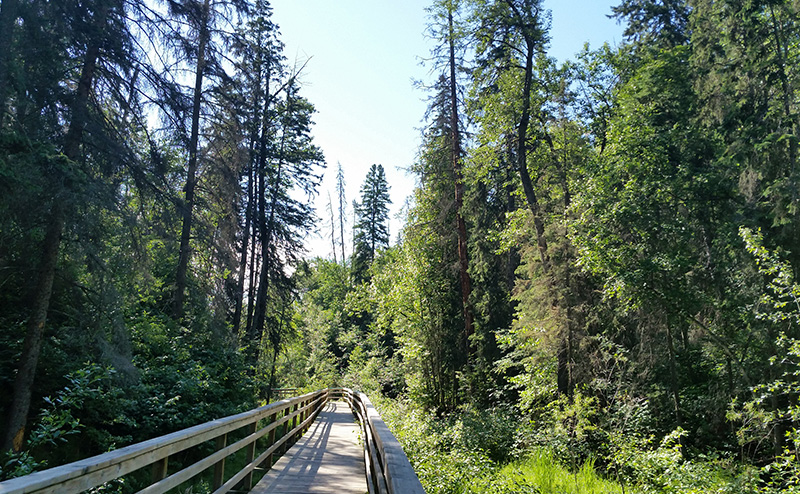The Natural Area Operations team has a dedicated Urban Forester that assesses trees around targets, for example, maintained trails and picnic sites, that may present a risk to people or property if they were to fall.
If a tree is identified as a higher risk, mitigation options will be explored. This may include:
- Pruning and removing dead branches or reducing the height of the tree while still maintaining the trunk for wildlife, which is called ‘habitating’
- Removing the tree entirely to minimize the risk of the tree causing injury or damage.

The City of Edmonton takes a thoughtful approach to managing wildland fire risk by combining it with efforts to create ecologically diverse and healthy natural areas, as outlined in our City Plan.
Overall risk for an area is currently assessed by examining factors such as:
- Slope (steepness of the forest floor)
- Aspect (direction the forest faces)
- Vegetation cover (which species are present)
- Fuel type (type of material such as, logs, branches or grass)
- Fuel continuity/pattern (scattered, clumped or continuous material on the forest floor)
Mitigation measures may include:
- Removing or chipping a portion of the fuels
- Removing dead trees
- Pruning
- Placing leaning dead trees on the forest floor to encourage decomposition
- Access for Fire Rescue Services
- Planting more fire-resistant species
- Applying FireSmart principles on your own property
The Natural Area Operations team regularly assesses and prunes trees and shrubs along maintained trails (asphalt or gravel) to ensure safety clearances are being met. This involves pruning a 1 metre buffer along the sides of trails, and 3 metres for height clearance over the trail. Branches may need to be trimmed further back than the minimum safety clearances to ensure proper pruning cuts are made.
The City aims to remove trees that have fallen on maintained trails within 48 hours once reported. Major storm events may cause delays in meeting our 48 hour target. Fallen trees on unmaintained trails will not be removed.
Crews collect garbage along the trail network on a weekly basis.
Our trail crews use the trail system daily and are constantly monitoring them for any safety concerns. If you see a fallen tree blocking a maintained trail, any tripping hazards along a trail, low overhanging branches, or an overflowing garbage container, please contact 311.

The Natural Area Operations team has a crew dedicated to removing Regulated Weeds by mechanical means only. When removing weeds in natural areas, the team first considers the environmental sensitivity of an area, the population dynamics of the weed species present, and the distribution of the species. Areas are prioritized based on the species present and their stage of growth.
We also monitor areas where prohibited noxious weeds are found. It evaluates the efficacy of treatments and provides insight into the long-term damage that prohibited noxious weed species have on our natural area ecosystems.
Our Natural Area Management Technician works closely with our Integrated Pest Management Team to ensure the best strategy is used on weeds throughout Edmonton's natural areas. Visit Weeds for more information on how the City uses an integrated management approach.

Please contact 311 if you plan to remove a live tree for a construction or work project. Tree preservation and protection are very important in project planning, and our Urban Foresters can help walk you through the process to ensure the preservation of our natural stands.
Any tree removal in a natural area must first be approved by our Urban Forester. If it is within the North Saskatchewan River Valley and Ravine Area, it may also require a project review under the North Saskatchewan River Valley Area Redevelopment Plan Bylaw 7188. Approved plans will also be required prior to any tree removals.
If your project is within 10 metres of a natural stand, a Tree Permit may be required as per Public Tree Bylaw 18825 . Visit Public Tree Permit for more information or to apply.
The Corporate Tree Management Policy and Procedure outline roles and responsibilities in managing the City of Edmonton Urban Forest and mechanisms to ensure preservation and protection. The Policy will be applied using the Natural Stand Valuation Guidelines if tree removals must occur.
For more information, please visit Trees and Construction.

Ecological monitoring is a critical part of natural area management. The Natural Area Operations team is completing ecological health surveys in various natural areas to better understand their current condition, and track changes over time.
Diseases and non-native species are part of our natural systems. The Natural Area Operations team will only intervene when there are Regulated Weeds impacting the natural area.
Examples of non-native species that are currently not managed:
- Manitoba maple
- European Mountain Ash
- Caragana
Examples of diseases that are currently not managed:
- Black Knot
- Canker



